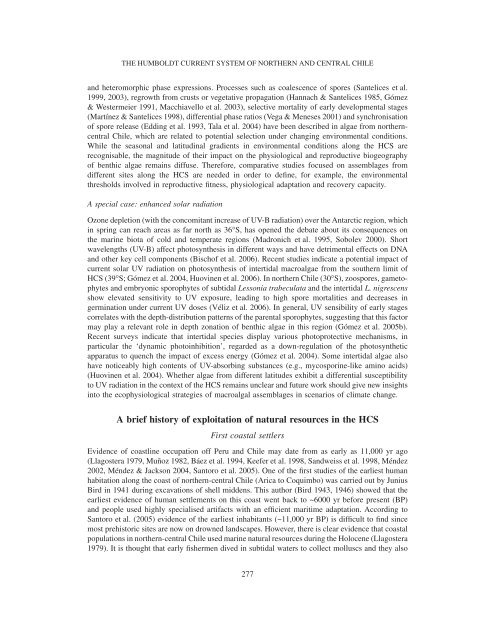the humboldt current system of northern and central chile - figema
the humboldt current system of northern and central chile - figema
the humboldt current system of northern and central chile - figema
You also want an ePaper? Increase the reach of your titles
YUMPU automatically turns print PDFs into web optimized ePapers that Google loves.
THE HUMBOLDT CURRENT SYSTEM OF NORTHERN AND CENTRAL CHILE<strong>and</strong> heteromorphic phase expressions. Processes such as coalescence <strong>of</strong> spores (Santelices et al.1999, 2003), regrowth from crusts or vegetative propagation (Hannach & Santelices 1985, Gómez& Westermeier 1991, Macchiavello et al. 2003), selective mortality <strong>of</strong> early developmental stages(Martínez & Santelices 1998), differential phase ratios (Vega & Meneses 2001) <strong>and</strong> synchronisation<strong>of</strong> spore release (Edding et al. 1993, Tala et al. 2004) have been described in algae from nor<strong>the</strong>rn<strong>central</strong>Chile, which are related to potential selection under changing environmental conditions.While <strong>the</strong> seasonal <strong>and</strong> latitudinal gradients in environmental conditions along <strong>the</strong> HCS arerecognisable, <strong>the</strong> magnitude <strong>of</strong> <strong>the</strong>ir impact on <strong>the</strong> physiological <strong>and</strong> reproductive biogeography<strong>of</strong> benthic algae remains diffuse. Therefore, comparative studies focused on assemblages fromdifferent sites along <strong>the</strong> HCS are needed in order to define, for example, <strong>the</strong> environmentalthresholds involved in reproductive fitness, physiological adaptation <strong>and</strong> recovery capacity.A special case: enhanced solar radiationOzone depletion (with <strong>the</strong> concomitant increase <strong>of</strong> UV-B radiation) over <strong>the</strong> Antarctic region, whichin spring can reach areas as far north as 36°S, has opened <strong>the</strong> debate about its consequences on<strong>the</strong> marine biota <strong>of</strong> cold <strong>and</strong> temperate regions (Madronich et al. 1995, Sobolev 2000). Shortwavelengths (UV-B) affect photosyn<strong>the</strong>sis in different ways <strong>and</strong> have detrimental effects on DNA<strong>and</strong> o<strong>the</strong>r key cell components (Bisch<strong>of</strong> et al. 2006). Recent studies indicate a potential impact <strong>of</strong><strong>current</strong> solar UV radiation on photosyn<strong>the</strong>sis <strong>of</strong> intertidal macroalgae from <strong>the</strong> sou<strong>the</strong>rn limit <strong>of</strong>HCS (39°S; Gómez et al. 2004, Huovinen et al. 2006). In nor<strong>the</strong>rn Chile (30°S), zoospores, gametophytes<strong>and</strong> embryonic sporophytes <strong>of</strong> subtidal Lessonia trabeculata <strong>and</strong> <strong>the</strong> intertidal L. nigrescensshow elevated sensitivity to UV exposure, leading to high spore mortalities <strong>and</strong> decreases ingermination under <strong>current</strong> UV doses (Véliz et al. 2006). In general, UV sensibility <strong>of</strong> early stagescorrelates with <strong>the</strong> depth-distribution patterns <strong>of</strong> <strong>the</strong> parental sporophytes, suggesting that this factormay play a relevant role in depth zonation <strong>of</strong> benthic algae in this region (Gómez et al. 2005b).Recent surveys indicate that intertidal species display various photoprotective mechanisms, inparticular <strong>the</strong> ‘dynamic photoinhibition’, regarded as a down-regulation <strong>of</strong> <strong>the</strong> photosyn<strong>the</strong>ticapparatus to quench <strong>the</strong> impact <strong>of</strong> excess energy (Gómez et al. 2004). Some intertidal algae alsohave noticeably high contents <strong>of</strong> UV-absorbing substances (e.g., mycosporine-like amino acids)(Huovinen et al. 2004). Whe<strong>the</strong>r algae from different latitudes exhibit a differential susceptibilityto UV radiation in <strong>the</strong> context <strong>of</strong> <strong>the</strong> HCS remains unclear <strong>and</strong> future work should give new insightsinto <strong>the</strong> ecophysiological strategies <strong>of</strong> macroalgal assemblages in scenarios <strong>of</strong> climate change.A brief history <strong>of</strong> exploitation <strong>of</strong> natural resources in <strong>the</strong> HCSFirst coastal settlersEvidence <strong>of</strong> coastline occupation <strong>of</strong>f Peru <strong>and</strong> Chile may date from as early as 11,000 yr ago(Llagostera 1979, Muñoz 1982, Báez et al. 1994, Keefer et al. 1998, S<strong>and</strong>weiss et al. 1998, Méndez2002, Méndez & Jackson 2004, Santoro et al. 2005). One <strong>of</strong> <strong>the</strong> first studies <strong>of</strong> <strong>the</strong> earliest humanhabitation along <strong>the</strong> coast <strong>of</strong> nor<strong>the</strong>rn-<strong>central</strong> Chile (Arica to Coquimbo) was carried out by JuniusBird in 1941 during excavations <strong>of</strong> shell middens. This author (Bird 1943, 1946) showed that <strong>the</strong>earliest evidence <strong>of</strong> human settlements on this coast went back to ~6000 yr before present (BP)<strong>and</strong> people used highly specialised artifacts with an efficient maritime adaptation. According toSantoro et al. (2005) evidence <strong>of</strong> <strong>the</strong> earliest inhabitants (~11,000 yr BP) is difficult to find sincemost prehistoric sites are now on drowned l<strong>and</strong>scapes. However, <strong>the</strong>re is clear evidence that coastalpopulations in nor<strong>the</strong>rn-<strong>central</strong> Chile used marine natural resources during <strong>the</strong> Holocene (Llagostera1979). It is thought that early fishermen dived in subtidal waters to collect molluscs <strong>and</strong> <strong>the</strong>y also277










